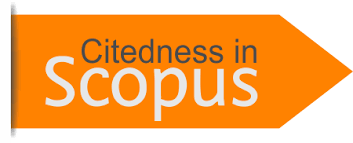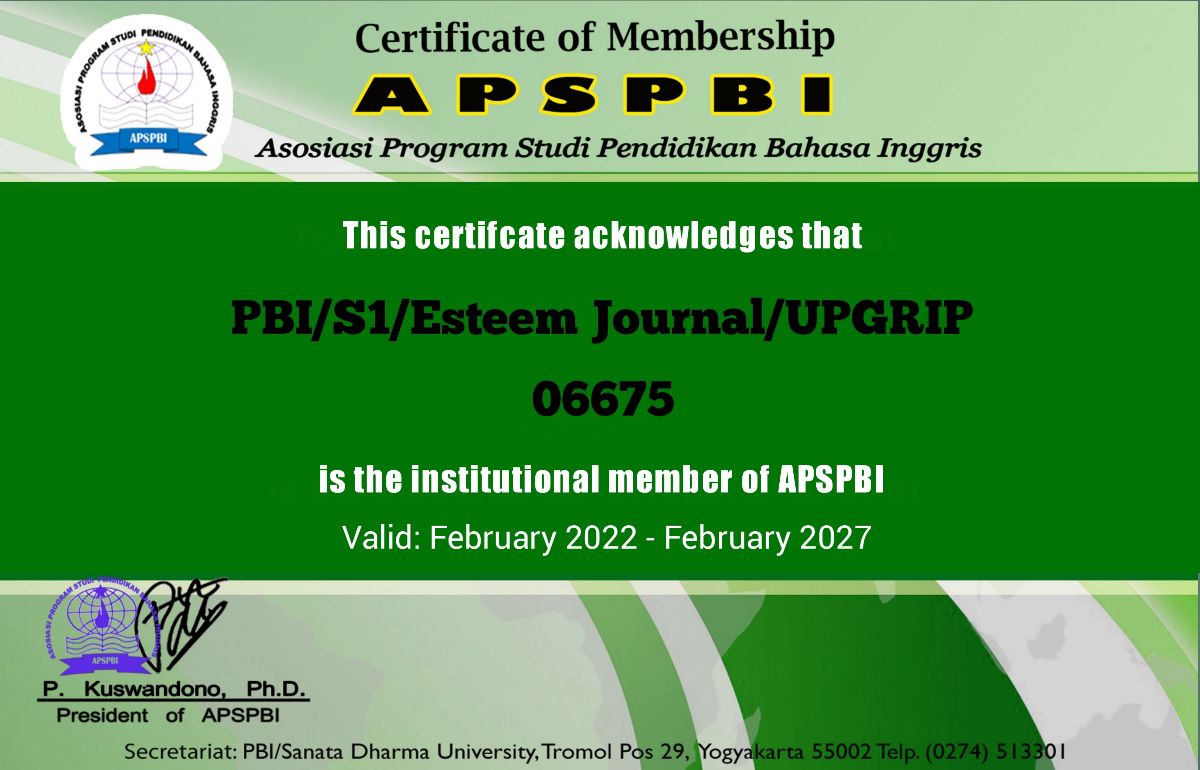THE INFLUENCE OF SELF- REGULATED LEARNING AND LEARNING ATTITUDE TOWARDS THE TENTH GRADE STUDENTS’ READING ABILITY
DOI:
https://doi.org/10.31851/esteem.v5i1.7456Keywords:
influence, self-regulated learning, learning Attitude, Result.Abstract
This research investigates the influence of self-regulated learning and learning attitude towards the tenth grade students’ reading ability of state SMK Negeri 8 Palembang. This study the researcher use quantitative technique and conduct utilizing a factorial design. The sample of this study are all of tenth grade students of SMK Negeri 8 Palembang that consist of 30 student for experimental group and 30 students for control group. Data collection techniques used questionnaires and tests. For the data analysis technique to find out the influence and the interaction effect used SPSS 20, The finding of this study are: (1) There are not significant influence of self-regulated learning and Learning attitude towards tenth grade students’ Reading Ability of those who have high motivation and those who have low motivation; (2) There was not significant interaction effect of Self-regulated Learning and Learning Attitude towards the students’ Reading Ability at SMK Negeri 8 Palembang.
References
Definition of Reading (as Originally Developed in Support NARAP Goal 1). Minneapolis, M.N.: National Accessible Reading Assesment Project
Fahriany. (2015). “Reading comprehension (A theory Analysis),†The paper was presented on International Conference on Education in Muslim Society, FITK UIN Syarif Hidayatullah Jakarta, Tangerang, 11-12 November 2015, p. 10.
Fraenkel, J. R. and Wallen. (2012). How to Design and Evaluate Research in Education (8th edition). New York, USA: McGraw-Hill.
Grabe M., et al., (2015), Guidlines on Urological Infections, European Association of Urology(EEU), 11.
Harmer, J. (2001). The Practice of English Language Teaching. New York. Longman.
Jain, V. (2014). 3D model of attitude. International Journal of Advanced Research in Management and Social Sciences, 3(3), 1-12.
Khan, I. A. (2016). Positive Attitude and English Language Learning: Psycho-pedagogic Connections. Arab world english Journal, 7(1), 432-444. doi:DOI: 10.6084/M9.FIGSHARE.3362560.V1
Perloff, R. M. (2003). The Dynamic of Persuassion: communication and attitudes. in the. (L. Bathgate, Ed.) New Jearsey: Laurence Erlbaum Associates.
Pintrich, P. (2000) The role of goal orientation in self-regulated learning. In: Boekaerts M, Pintrich P and Zeidner M (eds) Handbook of Self-Regulation, pp. 452±501. San Diego, CA: Academic Press
Ramdass, D., & Zimmerman, B. (2011). Developing self-regulated skills: The important role of homework. Journal of Advanced Academics, 22(2), 194–218.
Roohani, A., & Asiabani, S. (2015). Effects of self-regulated strategy development on EFL learners’ reading comprehension and metacognition. GEMA Online® Journal of Language Studies, 15(3).
Schunk, D. H., & Zimmerman, B. J. (Eds.). (2012). Motivation and self-regulated learning: Theory, research, and applications. Routledge.
Simaibang B, (2017) Second Edition ILT in a foreign Language Palembang Citra Books Indonesia
Zeinivanda, T., Azizifara, A., & Gowharya, H. (2015). The relationship between attitude and speaking proficiency of Iranians of EFL learners: The case of Darrehshehr city. Elsevier, 241-247.
Zimmerman, B. J., & Schunk, D. H. (Eds.). (2012). Self-regulated learning and academic achievement: Theory, research, and practice. Springer Science & Business Media.
Zimmerman, B. J., & Schunk, D. H. (Eds.). (2001). Self-regulated learning and academic achievement: Theoretical perspectives. Routledge.
Downloads
Published
Issue
Section
License
Copyright Notice
Authors who publish with this journal agree to the following terms:
In order to assure the highest standards for published articles, a peer review policy is applied. In pursue of the compliance with academic standards, all parties involved in the publishing process (the authors, the editors and the editorial board and the reviewers) agree to meet the responsibilities stated below in accordance to the Journal publication ethics and malpractice statement.
Duties of Authors:
- The author(s) warrant that the submitted article is an original work, which has not been previously published, and that they have obtained an agreement from any co-author(s) prior to the manuscript’s submission;
- The author(s) should not submit articles describing essentially the same research to more than one journal;
- The authors(s) make certain that the manuscript meets the terms of the Manuscript Submission Guideline regarding appropriate academic citation and that no copyright infringement occurs;
- The authors(s) should inform the editors about any conflict of interests and report any errors they subsequently, discover in their manuscript.
Duties of Editors and the Editorial Board:
- The editors, together with the editorial board, are responsible for deciding upon the publication or rejection of the submitted manuscripts based only on their originality, significance, and relevance to the domains of the journal;
- The editors evaluate the manuscripts compliance with academic criteria, the domains of the journal and the guidelines;
- The editors must at all times respect the confidentiality of any information pertaining to the submitted manuscripts;
- The editors assign the review of each manuscript to two reviewers chosen according to their domains of expertise. The editors must take into account any conflict of interest reported by the authors and the reviewers.
- The editors must ensure that the comments and recommendations of the reviewers are sent to the author(s) in due time and that the manuscripts are returned to the editors, who take the final decision to publish them or not.
Authors are permitted and encouraged to post online a pre-publication manuscript (but not the Publisher final formatted PDF version of the Work) in institutional repositories or on their Websites prior to and during the submission process, as it can lead to productive exchanges, as well as earlier and greater citation of published work (see The Effect of Open Access). Any such posting made before acceptance and publication of the Work shall be updated upon publication to include a reference to the Publisher-assigned DOI (Digital Object Identifier) and a link to the online abstract for the final published Work in the Journal.





























